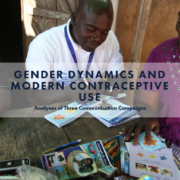New Research Examines Association Between Communication Campaigns, Gender Dynamics and Contraceptive Use
Gender dynamics play a role in the success of many social and behavior change communication (SBCC) programs.
For family planning programs, couple communication is a key predictor of contraceptive use. As a result, programs such as the Nigerian Urban Reproductive Health Initiative (NURHI) have incorporated couple communication and gender equity modeling in their health communication campaigns.
Though some studies have suggested that equitable gender dynamics are positively correlated with family planning, previous research found there was little evidence that family planning campaigns increase contraceptive use by influencing gender dynamics and relationship power. Another challenge with research questions on gender and family planning is that evaluations of family planning campaigns often do not sufficiently and consistently capture a range of gender variables, leaving room for uncertainty in conclusions.
To better examine the associations between communication campaigns, gender dynamics and contraceptive use, Health Communication Capacity Collaborative (HC3) researchers identified three campaign datasets that included variables needed to generate a more robust and conclusive analysis: NURHI, Urban Health Initiative (UHI) and Support for Service Delivery Integration (SSDI). After conducting multivariate and mediation analyses, the researchers concluded that “communication campaigns can have the additive effect of transforming gender dynamics if they are focused and contextually relevant to the gender issues of the particular audience.” Results also showed that the campaign which most clearly and constantly modeled mutual decision-making—NUHRI’s “Get it together” campaign—was also the most effective in influencing gender dynamics.
See HC3’s latest gender infographic for more information on the campaigns, results, conclusions and recommendations:









Leave a Reply
Want to join the discussion?Feel free to contribute!